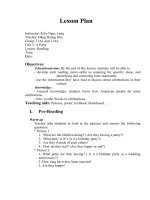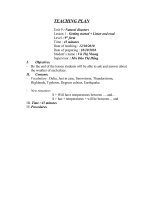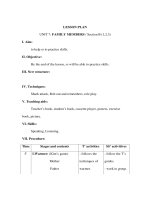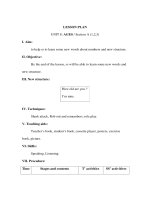- Trang chủ >>
- Mầm non - Tiểu học >>
- Lớp 2
Global Success_Grade 2_Lesson plan Unit 16_Giáo án Unit 16
Bạn đang xem bản rút gọn của tài liệu. Xem và tải ngay bản đầy đủ của tài liệu tại đây (93.02 KB, 15 trang )
TIẾNG ANH 2
LESSON PLAN
School:
Grade:
Teacher:
____________________
____________________
____________________
School year:
Week:
Approved by:
____________________
____________________
____________________
Unit 16. At the campsite
Lesson 1 – Period 1
Date: _______________
I. OBJECTIVES
II. INPUT
III. PROCEDURE
By the end of the lesson, pupils will be able to:
- correctly pronounce the name of the letter T/t (/tiː/);
- correctly recognize and pronounce the sound of the letter
T/t (/t/) in isolation and in the words tent, teapot and
blanket.
Language:
- Sound (/tiː/);
- Vocabulary: tent, teapot and blanket;
Resources/Material:
- Student’s book, p. 68
- Teacher’s guide, pp. 134-136
- hoclieu.vn
- Flashcards/pictures of family members
- Poster (Unit 16: At the campsite)
- Computer, projector
Warm-up – Listen and repeat – Point and say – Fun corner
1
– Wrap-up
Procedure
Warm-up
Teaching and learning activities
Classroom
management
5 minutes
Option 1: Singing the song in Unit 15, Lesson 3.
- Ask pupils to sing the song in Unit 15, Lesson 3
and point to the clothes (stick flashcards of
clothes on the board) when singing.
- Have some pupils demonstrate the song in
front of the class, the rest of the class listen to
them and clap hands. This can be set as groups
competition.
Option 2: Drawing.
- Show pupils some pictures/ slides of popular
clothes on the board.
- Have some pupils come to the board, teacher
says a word, then they will write the words
under the pictures and say it out loud.
Option 3: Game: What is it?
- Divide class into 4 groups.
- Show the pictures of clothes quickly, one by
one. Pupils raise their hands to say what the
pictures are. Give points to the ones who say
correctly. Ask the class to repeat the words to
review.
Whole class/
Group work
Individual
work/Group
work
Group work
1. Listen and repeat. 10 minutes
Step 1:
Have pupils look at the picture (saying “Look at
the picture, please!” and describe it (The picture
shows a family at the campsite). Draw pupils’ to
letter T/t (/tiː/); Say “Look at the picture. Who’s
this? (mum, dad, boy, girl / brother, sister).
Where are they? (At the campsite).
2
Whole class
Check comprehension.
Have pupils point to the letter T/t (say Point to Individual
Step 2: the letter T). Explain that the name of the letter
work
T/t is different to its sound (say “Listen. /tiː/
/t/.”).
Play the recording of the name and sound of the
letter T/t and encourage pupils to repeat (say Whole class/
Step 3: “Listen and repeat.”). Do this several times, Individual
pupils repeat individually and in chorus. Correct work
their pronunciation if necessary, and praise them
when their pronunciation is good.
Step 4:
Step
5:
Step
6:
Teach the words: Have pupils look at the tent
(say “Look at the tent.”), say “Point to the word
tent.” Draw their attention to the colour of the Whole class
letter t say “Look at the colour of the letter t.
What colour is it?”. (red).
Play the recording of tent and encourage pupils
to repeat (say “Listen and repeat.”). Do this
several times, with pupils repeating both Individual
individually and in chorus. Correct their work
pronunciation if necessary, praise them when
their pronunciation is good.
Do the same with the other words.
Individual
work
Play the recording in full and encourage pupils to Individual
Step 7: repeat the name and sound of the letter t, tent, work/
teapot and blanket both individually and in Whole class
chorus. Saying “Well done!” when they perform
well.
For higher level of pupils, using pictures/slides of
clothes, have the pupils make labels for the them
Individual
Extension: (shirts, shorts, shoes, …). Ask them to match the
work
words to the pictures and practise saying the
words.
2. Point and say. 7 minutes
3
Step 1: Have pupils point to the letter T/t and correctly Whole class
pronounce its name and sound (say “Point to work
the letter T. Say /tiː/. Now say /t/.”).
Step 2: Have pupils point to and correctly pronounce Whole class
tent (say “Point to the tent. Say tent.”). Do this
several times, with pupils repeating both Individual
individually and in chorus. Correct their work
pronunciation if necessary, praise and
encourage them.
Do the same with other words.
Step 3:
Put pupils into pairs or groups for further Group/
Step 4: practice of Steps 1 to 3. Go around the class to Pair work
offer help or correct pupils’ pronunciation, if
necessary.
Step 5:
Invite some pupils to point to the picture and
say the sound of the letter and the words in Individual
front of the class. If they perform well, praise work
them, saying “Well done!” or “Very good!”.
Extension: - For lower level of pupils, have them do
Activity 1,3, page 49 in their workbooks.
- For at or higher level of pupils, have them do
Activity 1-3, page 49 in their workbooks.
Fun corner:
Game: Matching game
8 minutes
Step 1: Stick the pictures and words on the board.
Stick the words around or outside the picture.
(Make sure that pupils have learnt the words
for all these things in previous unit, e.g. bag,
blanket, brother, cake, father, fox, juice,
mother, pasta, rainbow, river, road, sister,
table, teapot, tent, volleyball, yo-yos.).
Step 2: Tell pupils how to play the game: There are 2 Whole class
or 4 groups. Each group will send a pupil to
4
come to the front then take turns to label a
word under a picture correctly.
Step 3:
Wrap-up
Play the game. A correctly labelled item scores
one point. The team with the most points wins. Group work
5 minutes
- Revise the main teaching point of the lesson: Whole class
the sound and the words.
Option 1:
Using hoclieu.vn, have pupils look at the words
in the picture and repeat after the recording.
Option 2:
Using poster of the unit, ask pupils to point to
the words and say out. For better pupils,
teacher may cover the words and ask them to
point to the things and say the words aloud.
Option 3: Pass the ball game
Using pictures and flashcards, get pupils to
pass the ball one by one. Ask the one who
keeps the ball to say the words when the music
stop. Praise the ones who say it correctly. Then
ask the class to look and say the words aloud.
5
Whole class
Individual
work
Individual
work/ Whole
class
TIẾNG ANH 2
LESSON PLAN
School:
Grade:
Teacher:
____________________
____________________
____________________
School year:
Week:
Approved by:
____________________
____________________
____________________
Unit 16. At the campsite
Lesson 2 – Period 2
Date: _______________
I. OBJECTIVES
By the end of the lesson, pupils will be able to:
- pronounce the sound of the letter T/t (/t/), the words
tent, blanket, teapot and say the sentence structure The
_____ is on/in/near the _____. in a chant;
- recognize target words and sentence structures while
listening;
- complete and say the words tent, teapot and blanket;
II. INPUT
Language:
- Sound (/tiː/);
- Vocabulary: tent, teapot and blanket;
Resources/Material:
- Student’s book, p. 69
- hoclieu.vn
- Teacher’s guide, pp. 136-138
- Workbook, p. 50
- Computer, projector
6
III. PROCEDURE
Procedure
Warm-up
Warm-up – Listen and chant – Listen and circle – Write and
say – Wrap-up
Teaching and learning activities
Classroom
management
5 minutes
Option 1:
Ask two or three pupils to look at the picture in
Lesson 1 (Student’s book or hoclieu.vn) and say
the sound of the letter Tt /t/ and the words.
Option 2:
Show pictures of the words that pupils learnt in
Lesson 1 (tent, teapot, blanket) and encourage
them to say the words in chorus/groups. More
advanced classes can add other words
containing the letter t.
Option 3:
Get each pupil to draw their family going
camping including the words tent, teapot,
blanket then talk about the picture/photo to
their classmates.
Whole class
Group work
Individual
work
3. Listen and chant. 10 minutes
Step 1:
Have pupils look at the chant. Say Look at the
chant, please! Draw pupils’ attention to the
first verse and explain its meaning by looking
at the picture. Point to the tent/ fence.
Step 2:
Say “The tent is near the fence.” and
encourage pupils to repeat. To reinforce their
understanding, use gestures to indicate near
and far. Follow the same procedure with The
blanket is in the tent. and The teapot is on the
table.
Play the recording of the chant to familiarize
pupils with the words and rhythm, say
“Listen!”.
7
Step 3:
Whole class
Whole class
Whole class
Step 4:
Step 5:
Have pupils point to the first line of the chant
(say “Point to line one.”). Play the recording of
the first line and encourage pupils to chant
(say “Listen and chant.”).
Play the recording in full and encourage pupils
to chant (say “Listen and chant.”). Pupils can
clap along or do other actions to help them
keep the rhythm.
Divide the class into two teams. Teams take it
in turns to chant a line. The whole class can
Step 6: clap along or do other actions.
1. Ask pupils to look at the picture in Activity 3,
work in pairs and take turns chanting
Extension: together.
2. For better pupils, cover some letters/words
in the chant and have them guess and say all
the lines aloud. For example:
T, t, _______.
The tent is near the _______.
T, t, _______.
The blanket is in the _______.
T, t, _______.
The teapot is on the _______.
4. Listen and circle.
Group work/
Individual
work
Individual
work
Group work
Pair work/
Individual
work
7 minutes
Step 1: Have pupils look at the pictures of Question 1 Whole class
and say (say “Look at the pictures and say,
please!”). Draw pupils’ attention to the pictures
above the letters a and b. Check
comprehension.
Step 2: Invite some pupils to point to the pictures and
say the words in front of the class (say “Point to Individual
work
the pictures and say, please!”. E.g.: 1 (a):
a teapot on a table and (b) a blanket on a table.
8
Step 3: Play the recording of the first sentence for
pupils to listen and circle the correct letter (a or
b). Say “Now listen and circle, please!”. Play the
recording of the first sentence, several times if
necessary, for pupils and check uderstanding:
“What did you hear?, We circle a, or b?”. If they
answer correctly, praise them “Very good!” or
Well done!
Step 4: Follow the same procedure with the pictures in
Question 2. Give further support to those pupils
who find it difficult to do the task.
Step 5: Call a few pupils to the front of the class to point
to the pictures and say what they have heard.
Check answer:
Audio script: 1. A teapot is on the table.
2. A blanket is in the tent.
Answers: 1. a 2. b
Individual
work
Whole class
Pair work/
Whole class
5. Write and say. 8 minutes
Step 1:
Have pupils look at the letter Tt (say “Look at
this. What can you see?”) (letter Tt). Write the
letter t (lower case) on the board and say “t”
(/t/).
Step 2: Write the letter t (lower case) on the board
again, but this time more slowly. Invite a few
pupils to come to the front of the class and
write the letter t (lower case) on the board.
Step 3:
Draw pupils’ attention to the pictures and labels
(say “Look and write.”). Allow pupils time to
complete the activity. Go around the class to
Step 4: offer support and feedback.
Have pupils say the words (say “Say the
words.”).
Extension:
- For lower level of pupils, have them do Activity
4,5, page 50 in their workbooks.
9
Whole class
Whole class
Individual
work
Individual
work/ Whole
class
Individual
work
- For higher level of pupils, have them do
Activity 4,5, page 50 in their workbooks, then
say it oud loud.
Wrap-up:
5 minutes
Option 1: Have pupils listen to the recording,
then say the chant again.
Option 2: Ask pupils to look at the pictures in
Activity 4: Listen and circle, then talk about the
pictures. Encourage higher level of pupils to use
learnt structures e.g. The tent is near the fence,
The blanket is in the tent, The teapot is on the
table.
Option 3: Game: Pass the ball.
Ask pupils to pass the ball with the music. When
the music stops, the one keeps the ball has to
say the words about camping they have learnt
so far.
10
Whole class
Whole class/
Individual
work
Individual
work
TIẾNG ANH 2
LESSON PLAN
School:
Grade:
Teacher:
____________________
____________________
____________________
School year:
Week:
Approved by:
____________________
____________________
____________________
Unit 16. At the campsite
Lesson 3 – Period 3
Date: _______________
I. OBJECTIVES
By the end of the lesson, pupils will be able to:
- use the sentence structures Is the _____ near _____?
and No, it isn’t. It’s _____. to ask and answer questions
about the position of things;
- sing a song with the sentence structures Is the _____ near
_____? and No, it isn’t. It’s _____.
II. INPUT
Language:
Ask and answer questions about the position of things Is the
_____ near _____? and No, it isn’t. It’s _____.
Resources/Material:
- Student’s book, p. 70
- hoclieu.vn
- Teacher’s guide, pp. 138-140
- Workbook, p. 51
- Computer, projector
11
III. PROCEDURE
Procedure
Warm-up
Warm-up – Listen and repeat – Let’s talk – Let’s sing –
Wrap up
Teaching and learning activities
Classroom
management
5 minutes
Option
1:
- Have pupils listen to the recording, then
sing/read the chant in Lesson 2.
- Select some pupils to chant in front of class.
The class listens to them and claps hands along.
Whole
class/Group
work
(competition
between
groups)
Option 2:
Whole class/
- Show pictures/ slides of tent, teapot and Individual
blanket quickly and let the pupils guess/ say it work
out loud.
- Ask them to recall then encourage higher level
of pupils to say more words/phrases about
camping if they can.
Group work
Option 3:
- Invite one or two pupils to write the letter Tt
and some words with these letters on the board.
Make it become a competition between groups
to be more interesting.
6. Listen and repeat. 5 minutes
Step 1: Have pupils look at the picture, point to the boy Whole class
and the girl, then say “Who are they? (a boy and
a girl), What do you see in the picture? (a tent, a
blanket); We ask: Is the blanket near the tent?
(point to the blanket and the tent). No, it isn’t.
It’s in the tent.” Explain the meaning of the
sentence and how it is used. Check
comprehension.
Step 2: Play the recording several times for pupils to Whole class
listen and repeat the sentences, saying “Now
12
listen and repeat, please!”.
Step 3: Play the recording and invite some students to
repeat the sentences “Is the blanket near the
tent?”, “No, it isn’t. It’s in the tent.” Correct
pronunciation to make sure pupils can repeat
correctly the sentence. Give further support to
those pupils who find it difficult to do the task.
Step 4: Invite some pupils to practice asking and
answering in front of the class.
7. Let’s talk.
Individual
work
Individual
work
10 minutes
Step 1: Have pupils look at the bubble to understand
and practice structure Is the _____ near the
_____? No, ____. It’s ____. Explain the meaning
of the sentence, if necessary.
Step 2: Have pupils look at the first picture. Point and
say “Look at this picture, please!” Point to
picture a and ask them “What is this? (a tent
and a blanket). Is the blanket near the tent?. No,
it isn’t. It’s in the tent.”
Point to Picture a and model, using the
Step 3: expression in the bubble and the picture. Write
Is the _____ near the _____? No, ____. It’s ____.
on the board.
Step 4: Ask pupils to point to Picture a, b, c, practice
saying with their friends.
Step 5: Select some pupils to practise asking and
answering in front of the class. Praise them,
saying Excellent! if they perform well.
Step 6: Have pupils work in pairs to look at each picture
and practise asking and answering questions
about the position of things. Go around the class
to offer support and feedback.
Divide the class into four groups. Show pictures
Extension:
of camping things very quickly. Students from 4
13
Whole class
Whole class
Whole class
Whole class
Whole class/
Individual
work
Pair work
Group work
groups will raise their hands to answer the
questions: How old is your sister/ brother? in
their memory. Give points to the winner.
8. Let’s sing. 10 minutes
Step 1: Have pupils read the lyrics to get familiarized
themselves with the first verse of the song. Say
“Now look at the first verse, please!” Check
comprehension.
Step 2: Play the recording several times for pupils to
repeat line after line to make sure that they can
sing the first verse correctly. Say “Listen and
repeat, please!”
Step 3: Follow the same procedure with the second
verse of the lyrics. Praise them when they
perform well, saying Excellent!
Step 4: Have pupils listen to the whole song and sing
along. Draw their attention to the pronunciation,
the stress and the melody of the song, saying
“Now listen to the whole song and sing, please!”
Let pupils practise singing the song.
Step 5: If there is more time, let them sing the song
several times or ask some pupils to sing the song
individually.
Extension: 1. Practise three-part singing. Divide the class
into three groups and ask each group to sing one
part of the song.
2. - For lower level of pupils, have them do
Activity 6,7, page 51 in their workbooks.
- For at or higher level of pupils, have them do
Activity 6,7, page 51 in their workbooks then
practice speaking with their classmates.
14
Whole class
Whole class
Whole class
Whole class
Individual
work
Group work
Wrap-up
5 minutes
- Revise the main teaching point of the lesson:
the structure Is the _____ near _____? and No, it
isn’t. It’s _____.
Option 1: Ask pupils to draw/ show pictures of a
camping site and talk about them, using Is the
_____ near _____? and No, it isn’t. It’s _____.
Option 2:
Show pupils the lyrics of the song with some
missing words, e.g.:
Is the ________ near the tent?
No, it isn’t. It’s in the tent.
Is the ________ near the tent?
No, it isn’t. It’s in the tent.
Is the ________ near the table?
No, it isn’t. It’s on the table.
Then ask some advanced pupils to guess the
missing words and sing the complete song aloud.
15
Whole class
Individual
work
Individual
work/ Whole
class









